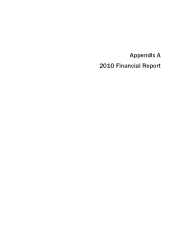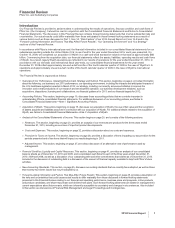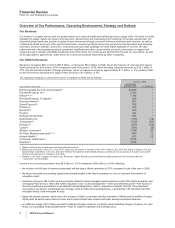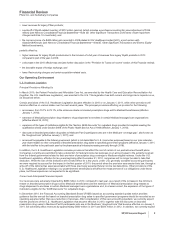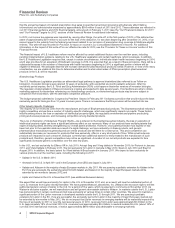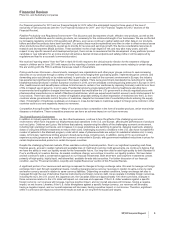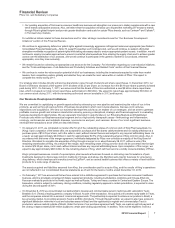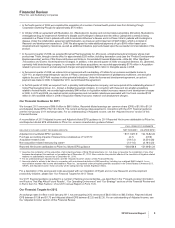Pfizer 2010 Annual Report Download - page 6
Download and view the complete annual report
Please find page 6 of the 2010 Pfizer annual report below. You can navigate through the pages in the report by either clicking on the pages listed below, or by using the keyword search tool below to find specific information within the annual report.
Financial Review
Pfizer Inc. and Subsidiary Companies
that the annual fee based on branded prescription drug sales to specified government programs will adversely affect Selling,
informational and administrative expenses by approximately $300 million in each of 2011 and 2012. These estimates are reflected in
our 2011 financial guidance and 2012 financial targets, announced on February 1, 2011 (see the “Our Financial Guidance for 2011”
and “Our Financial Targets for 2012” sections of this Financial Review for additional information).
In 2010, our income tax expense was impacted by, among other things, the write-off, in the first quarter of 2010, of the deferred tax
asset of approximately $270 million to account for the loss of the deduction, for tax years beginning after December 31, 2012, of an
amount equal to the subsidy from the federal government related to our provision of prescription drug coverage to Medicare-eligible
retirees. This write-off was recorded in Provision for taxes on income in our Consolidated Statement of Income. For additional
information on the impact of this write-off on our effective tax rate for 2010, see the “Provision for Taxes on Income” section of this
Financial Review.
The financial impact of U.S. healthcare reform may be affected by certain additional factors over the next few years, including
pending implementation guidance relating to the U.S. Healthcare Legislation and certain healthcare reform proposals. In addition,
the U.S. Healthcare Legislation requires that, except in certain circumstances, individuals obtain health insurance beginning in 2014,
and it also provides for an expansion of Medicaid coverage in 2014. It is expected that, as a result of these provisions, there will be a
substantial increase in the number of Americans with health insurance beginning in 2014, a significant portion of whom will be
eligible for Medicaid. We anticipate that this will increase demand for pharmaceutical products overall. However, in view of the many
uncertainties, we are unable at this time to determine whether and to what extent sales of Pfizer prescription pharmaceutical
products in the U.S. will be impacted.
Biotechnology Products
The U.S. Healthcare Legislation provides an abbreviated legal pathway to approve biosimilars (also referred to as “follow-on
biologics”). Innovator biologics were granted 12 years of exclusivity, with a potential six-month pediatric extension. After the
exclusivity period expires, the U.S. Food and Drug Administration (FDA) could approve biosimilar versions of innovator biologics.
The regulatory implementation of these provisions is ongoing and expected to take several years. If competitors are able to obtain
marketing approval for biosimilars referencing our biotechnology products, our biotechnology products may become subject to
competition from biosimilars, with the attendant competitive pressure.
The budget proposal submitted to Congress by President Obama in February 2011 includes a provision that would reduce the base
exclusivity period for biologics from 12 years to seven years. There is no assurance that this provision will be enacted into law.
Other Industry-Specific Challenges
The majority of our revenues come from the manufacture and sale of Biopharmaceutical products. The biopharmaceutical industry is
highly competitive and we face a number of industry-specific challenges, which can significantly impact our results. These factors
include among others: the loss or expiration of intellectual property rights, the regulatory environment and pipeline productivity,
pricing and access pressures, and increasing competition among branded products.
The Loss or Expiration of Intellectual Property Rights––As is inherent in the biopharmaceutical industry, the loss or expiration of
intellectual property rights can have a significant adverse effect on our revenues. Many of our products have multiple patents that
expire at varying dates, thereby strengthening our overall patent protection. However, once patent protection has expired or has
been lost prior to the expiration date as a result of a legal challenge, we lose exclusivity on these products, and generic
pharmaceutical manufacturers generally produce similar products and sell them for a lower price. This price competition can
substantially decrease our revenues for products that lose exclusivity, often in a very short period of time. While small molecule
products are impacted in such a manner, biologics currently have additional barriers to entry related to the manufacture of such
products and, therefore, generic competition may not be as significant. A number of our current products are expected to face
significantly increased generic competition over the next few years.
In the U.S., we lost exclusivity for Effexor XR in July 2010, Aricept 5mg and 10mg tablets in November 2010, for Protonix in January
2011, and Vfend tablets in February 2011. We lost exclusivity for Lipitor in Canada in May 2010, Spain in July 2010 and Brazil in
August 2010. In addition, the basic patent for Vfend tablets in Brazil expired in January 2011. We expect to lose exclusivity for
various products over the next few years, including the following in 2011:
•Xalatan in the U.S. in March 2011;
•Aromasin in the U.S. in April 2011 and in the European Union (EU) and Japan in July 2011;
•Xalatan and Xalacom in the majority of major European markets in July 2011. We are pursuing a pediatric extension for Xalatan in the
EU. If we are successful, the exclusivity period for both Xalatan and Xalacom in the majority of major European markets will be
extended by six months to January 2012; and
•Lipitor and Caduet in the U.S. in November 2011 (see additional discussion below).
We expect that we will lose exclusivity for Lipitor in the U.S. in November 2011 and, as a result, will lose the substantial portion of
our U.S. revenues from Lipitor shortly thereafter. We have granted Watson Laboratories, Inc. (Watson) the exclusive right to sell the
authorized generic version of Lipitor in the U.S. for a period of five years, which is expected to commence in November 2011. As
Watson’s exclusive supplier, we will manufacture and sell generic atorvastatin tablets to Watson. In markets outside the U.S., Lipitor
has lost exclusivity in certain countries and will lose exclusivity at various times in certain other countries. We expect to maintain a
significant portion of the Lipitor revenues in developed markets outside the U.S. through 2011. We are pursuing a pediatric
extension for Lipitor in the EU. If we are successful, the exclusivity period for Lipitor in the majority of major European markets will
be extended by six months to May 2012. We do not expect that Lipitor revenues in emerging markets will be materially impacted by
the loss of exclusivity in 2011 or over the next several years. In 2010, revenues from Lipitor were approximately $5.3 billion in the
U.S. (approximately 18% of our total 2010 U.S. revenues) and approximately $5.4 billion in markets outside the U.S. (about 14% of
our total 2010 international revenues, of which approximately $900 million was attributable to emerging markets).
4 2010 Financial Report

